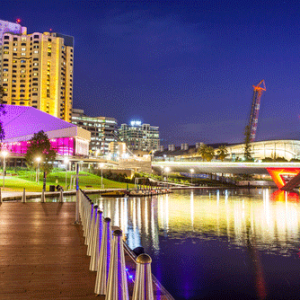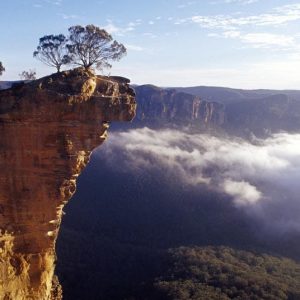Australia
Australia officially the Commonwealth of Australia, is an Oceania country comprising the mainland of the Australian continent, the island of Tasmania, and numerous smaller islands. It is the world’s sixth-largest country by total area. Neighboring countries include Papua New Guinea, Indonesia and East Timor to the north; the Solomon Islands and Vanuatu to the north-east; and New Zealand to the south-east.
For about 50,000 years before the first British settlement in the late 18th century, Australia was inhabited by indigenous Australians, who spoke languages grouped into roughly 250 language groups. After the European discovery of the continent by Dutch explorers in 1606, Australia’s eastern half was claimed by Great Britain in 1770 and initially settled through penal transportation to the colony of New South Wales from 26 January 1788. The population grew steadily in subsequent decades; the continent was explored and an additional five self-governing crown colonies were established. On 1 January 1901, the six colonies federated, forming the Commonwealth of Australia. Since federation, Australia has maintained a stable liberal democratic political system that functions as a federal parliamentary democracy and constitutional monarchy comprising six states and several territories. The population of 23.6 million is highly urbanized and heavily concentrated in the eastern states and on the coast.
Australia is a developed country and one of the wealthiest in the world, with the world’s 12th-largest economy. In 2014 Australia had the world’s fifth-highest per capita income. Australia’s military expenditure is the world’s 13th-largest. With the second-highest human development index globally, Australia ranks highly in many international comparisons of national performance, such as quality of life, health, education, economic freedom, and the protection of civil liberties and political rights. Australia is a member of the United Nations, G20, Commonwealth of Nations, ANZUS, Organization for Economic Co-operation and Development (OECD), World Trade Organization, Asia-Pacific Economic Cooperation, and the Pacific Islands Forum.
Australia has six states—New South Wales (NSW), Queensland (QLD), South Australia (SA), Tasmania (TAS), Victoria (VIC) and Western Australia (WA)—and two major mainland territories—the Australian Capital Territory (ACT) and the Northern Territory (NT). In most respects these two territories function as states, but the Commonwealth Parliament can override any legislation of their parliaments. By contrast, federal legislation overrides state legislation only in areas that are set out in Section 51 of the Australian Constitution; state parliaments retain all residual legislative powers, including those over schools, state police, the state judiciary, roads, public transport and local government, since these do not fall under the provisions listed in Section 51.
Each state and major mainland territory has its own parliament—unicameral in the Northern Territory, the ACT and Queensland, and bicameral in the other states. The states are sovereign entities, although subject to certain powers of the Commonwealth as defined by the Constitution. The lower houses are known as the Legislative Assembly (the House of Assembly in South Australia and Tasmania); the upper houses are known as the Legislative Council. The head of the government in each state is the Premier and in each territory the Chief Minister. The Queen is represented in each state by a Governor; and in the Northern Territory, the Administrator. In the Commonwealth, the Queen’s representative is the Governor-General.
The federal parliament directly administers the following territories:
- Ashmore and Cartier Islands
- Australian Antarctic Territory
- Christmas Island
- Cocos (Keeling) Islands
- Coral Sea Islands
- Heard Island and McDonald Islands
- Jervis Bay Territory, a naval base and sea port for the national capital in land that was formerly part of New South Wales
The external territory of Norfolk Island previously exercised considerable autonomy under the Norfolk Island Act 1979 through its own legislative assembly and an Administrator to represent the Queen. In 2015, the Commonwealth Parliament abolished self-government, integrating Norfolk Island into the Australian tax and welfare systems and replacing its legislative assembly with a council.
Macquarie Island is administered by Tasmania, and Lord Howe Island by New South Wales.
Australia’s landmass of 7,617,930 square kilometers (2,941,300 sq mi) is on the Indo-Australian Plate. Surrounded by the Indian and Pacific oceans, it is separated from Asia by the Arafura and Timor seas, with the Coral Sea lying off the Queensland coast, and the Tasman Sea lying between Australia and New Zealand. The world’s smallest continent and sixth largest country by total area, Australia—owing to its size and isolation—is often dubbed the “island continent”, and is sometimes considered the world’s largest island.[125] Australia has 34,218 kilometers (21,262 mi) of coastline (excluding all offshore islands), and claims an extensive Exclusive Economic Zone of 8,148,250 square kilometres (3,146,060 sq mi). This exclusive economic zone does not include the Australian Antarctic Territory. Apart from Macquarie Island, Australia lies between latitudes 9° and 44°S, and longitudes 112° and 154°E.
The Great Barrier Reef, the world’s largest coral reef, lies a short distance off the north-east coast and extends for over 2,000 kilometres (1,240 mi). Mount Augustus, claimed to be the world’s largest monolith, is located in Western Australia. At 2,228 metres (7,310 ft), Mount Kosciuszko on the Great Dividing Range is the highest mountain on the Australian mainland. Even taller are Mawson Peak (at 2,745 metres or 9,006 feet), on the remote Australian territory of Heard Island, and, in the Australian Antarctic Territory, Mount McClintock and Mount Menzies, at 3,492 metres (11,457 ft) and 3,355 metres (11,007 ft) respectively.
Australia’s size gives it a wide variety of landscapes, with tropical rainforests in the north-east, mountain ranges in the south-east, south-west and east, and dry desert in the centre. It is the flattest continent, with the oldest and least fertile soils; desert or semi-arid land commonly known as the outback makes up by far the largest portion of land.[135] The driest inhabited continent, its annual rainfall averaged over continental area is less than 500 mm. The population density, 2.8 inhabitants per square kilometer, is among the lowest in the world, although a large proportion of the population lives along the temperate south-eastern coastline.
Eastern Australia is marked by the Great Dividing Range, which runs parallel to the coast of Queensland, New South Wales and much of Victoria. The name is not strictly accurate, because parts of the range consist of low hills, and the highlands are typically no more than 1,600 metres (5,249 ft) in height.[139] The coastal uplands and a belt of Brigalow grasslands lie between the coast and the mountains, while inland of the dividing range are large areas of grassland. These include the western plains of New South Wales, and the Einasleigh Uplands, Barkly Tableland, and Mulga Lands of inland Queensland. The northernmost point of the east coast is the tropical-rainforested Cape York Peninsula.
The landscapes of the Top End and the Gulf Country—with their tropical climate—include forest, woodland, wetland, grassland, rainforest and desert. At the north-west corner of the continent are the sandstone cliffs and gorges of The Kimberley, and below that the Pilbara. To the south of these and inland, lie more areas of grassland: the Ord Victoria Plain and the Western Australian Mulga shrublands. At the heart of the country are the uplands of central Australia. Prominent features of the centre and south include Uluru (also known as Ayers Rock), the famous sandstone monolith, and the inland Simpson, Tirari and Sturt Stony, Gibson, Great Sandy, Tanami, and Great Victoria deserts, with the famous Nullarbor Plain on the southern coast.
The climate of Australia is significantly influenced by ocean currents, including the Indian Ocean Dipole and the El Niño–Southern Oscillation, which is correlated with periodic drought, and the seasonal tropical low-pressure system that produces cyclones in northern Australia. These factors cause rainfall to vary markedly from year to year. Much of the northern part of the country has a tropical, predominantly summer-rainfall (monsoon) climate. The south-west corner of the country has a Mediterranean climate. Much of the south-east (including Tasmania) is temperate.
Although Australia has no official language, English has always been entrenched as the de facto national language. Australian English is a major variety of the language with a distinctive accent and lexicon, and differs slightly from other varieties of English in grammar and spelling. General Australian serves as the standard dialect. According to the 2011 census, English is the only language spoken in the home for close to 81% of the population. The next most common languages spoken at home are Mandarin (1.7%), Italian (1.5%), Arabic (1.4%), Cantonese (1.3%), Greek (1.3%), and Vietnamese (1.2%); a considerable proportion of first- and second-generation migrants are bilingual. A 2010–2011 study by the Australia Early Development Index found the most common language spoken by children after English was Arabic, followed by Vietnamese, Greek, Chinese, and Hindi.
Over 250 Indigenous Australian languages are thought to have existed at the time of first European contact, of which less than 20 are still in daily use by all age groups. About 110 others are spoken exclusively by older people. At the time of the 2006 census, 52,000 Indigenous Australians, representing 12% of the Indigenous population, reported that they spoke an Indigenous language at home. Australia has a sign language known as Auslan, which is the main language of about 5,500 deaf people.
Australia has no state religion; Section 116 of the Australian Constitution prohibits the federal government from making any law to establish any religion, impose any religious observance, or prohibit the free exercise of any religion. In the 2011 census, 61.1% of Australians were counted as Christian, including 25.3% as Roman Catholic and 17.1% as Anglican; 22.3% of the population reported having “no religion”; 7.2% identify with non-Christian religions, the largest of these being Buddhism (2.5%), followed by Islam (2.2%), Hinduism (1.3%) and Judaism (0.5%). The remaining 9.4% of the population did not provide an adequate answer.
Before European settlement, the animist beliefs of Australia’s indigenous people had been practiced for many thousands of years. Mainland Aboriginal Australians’ spirituality is known as the Dreamtime and it places a heavy emphasis on belonging to the land. The collection of stories that it contains shaped Aboriginal law and customs. Aboriginal art, story and dance continue to draw on these spiritual traditions. The spirituality and customs of Torres Strait Islanders, who inhabit the islands between Australia and New Guinea, reflected their Melanesian origins and dependence on the sea. The 1996 Australian census counted more than 7000 respondents as followers of a traditional Aboriginal religion.
Since the arrival of the First Fleet of British ships in 1788, Christianity has grown to be the major religion practiced in Australia. Christian churches have played an integral role in the development of education, health and welfare services in Australia. For much of Australian history the Church of England (now known as the Anglican Church of Australia) was the largest religious denomination. However, multicultural immigration has contributed to a decline in its relative position, and the Roman Catholic Church has benefited from recent immigration to become the largest group. Similarly, Islam, Buddhism, Hinduism and Judaism have all grown in
Since 1788, the basis of Australian culture has been strongly influenced by Anglo-Celtic Western culture. Distinctive cultural features have also arisen from Australia’s natural environment and Indigenous cultures. Since the mid-20th century, American popular culture has strongly influenced Australia, particularly through television and cinema. Other cultural influences come from neighboring Asian countries, and through large-scale immigration from non-English-speaking nations.
The rock art of Australia’s Indigenous peoples is the oldest and richest in the world, dating as far back as 60,000 years and spread across hundreds of thousands of sites. Traditional designs, patterns and stories infuse contemporary Indigenous Australian art, “the last great art movement of the 20th century”; its exponents include Emily Kame Kngwarreye. During the first century of European settlement, colonial artists, trained in Europe, showed a fascination with the unfamiliar land. The naturalistic, sun-filled works of Arthur Streeton, Tom Roberts and others associated with the 19th-century Heidelberg School—the first “distinctively Australian” movement in Western art—gave expression to a burgeoning Australian nationalism in the lead-up to Federation. While the school remained influential into the new century, modernists such as Margaret Preston, and, later, Sidney Nolan and Arthur Boyd, explored new artistic trends. The landscape remained a central subject matter for Fred Williams, Brett Whiteley and other post-World War II artists whose works, eclectic in style yet uniquely Australian, moved between the figurative and the abstract. The National Gallery of Australia and state galleries maintain collections of Australian and international art.[298] Australia has one of the world’s highest attendances of art galleries and museums per head of population.
Australian literature grew slowly in the decades following European settlement though Indigenous oral traditions, many of which have since been recorded in writing, are much older. Writers of the 19th-century Bulletin School, such as Henry Lawson and Banjo Paterson, captured the experience of the bush using a distinctive Australian vocabulary. Their works are still very popular; Paterson’s bush poem “Waltzing Matilda” (1895) is regarded as Australia’s unofficial national anthem.[302] Miles Franklin is the namesake of Australia’s most prestigious literary prize, awarded to the best novel about Australian life. Its first recipient, Patrick White, went on to win the Nobel Prize in Literature in 1973. Australian winners of the Man Booker Prize include Peter Carey, Thomas Keneally and Richard Flanagan. Author David Malouf, playwright David Williamson and poet Les Murray are also renowned literary figures.
Many of Australia’s performing arts companies receive funding through the federal government’s Australia Council. There is a symphony orchestra in each state, and a national opera company, Opera Australia, well known for its famous soprano Joan Sutherland. At the beginning of the 20th century, Nellie Melba was one of the world’s leading opera singers. Ballet and dance are represented by The Australian Ballet and various state companies. Each state has a publicly funded theater company.
The Story of the Kelly Gang (1906), the world’s first feature length film, spurred a boom in Australian cinema during the silent film era. After World War I, Hollywood monopolised the industry, and by the 1960s Australian film production had effectively ceased. With the benefit of government support, the Australian New Wave of the 1970s brought provocative and successful films, many exploring the nation’s colonial past, such as Picnic at Hanging Rock and Breaker Morant, while the so-called Ozploitation genre produced international blockbusters, including the Mad Max series.[318] More recent successes included Shine and Rabbit-Proof Fence. Notable Australian actors include Errol Flynn, Judith Anderson, Geoffrey Rush, Nicole Kidman, Heath Ledger and Cate Blanchett.
Australia has two public broadcasters (the Australian Broadcasting Corporation and the multicultural Special Broadcasting Service), three commercial television networks, several pay-TV services, and numerous public, non-profit television and radio stations. Each major city has at least one daily newspaper, and there are two national daily newspapers, The Australian and The Australian Financial Review. In 2010, Reporters Without Borders placed Australia 18th on a list of 178 countries ranked by press freedom, behind New Zealand (8th) but ahead of the United Kingdom (19th) and United States (20th). This relatively low ranking is primarily because of the limited diversity of commercial media ownership in Australia;[324] most print media are under the control of News Corporation and Fairfax Media.
Most Indigenous Australian tribal groups subsisted on a simple hunter-gatherer diet of native fauna and flora, otherwise called bush tucker. The first settlers introduced British food to the continent, much of which is now considered typical Australian food, such as the Sunday roast. Multicultural immigration transformed Australian cuisine; post-World War II European migrants, particularly from the Mediterranean, helped to build a thriving Australian coffee culture, and the influence of Asian cultures has led to Australian variants of their staple foods, such as the Chinese-inspired dim sim and Chiko Roll. Vegemite, pavlova, lamingtons and meat pies are regarded as iconic Australian foods. Australian wine is produced mainly in the southern, cooler parts of the country.
About 24% of Australians over the age of 15 regularly participate in organized sporting activities. At an international level, Australia has excelled at cricket, field hockey, netball, rugby league and rugby union. The majority of Australians live within the coastal zone, making the beach a popular recreation spot and an integral part of the nation’s identity. Australia is a powerhouse in water-based sports, such as swimming and surfing. The surf lifesaving movement originated in Australia, and the volunteer lifesaver is one of the country’s icons. Nationally, other popular sports include Australian rules football, horse racing, squash, surfing, soccer, and motor racing. The annual Melbourne Cup horse race and the Sydney to Hobart yacht race attract intense interest.
Australia is one of five nations to have participated in every Summer Olympics of the modern era, and has hosted the Games twice: 1956 in Melbourne and 2000 in Sydney. Australia has also participated in every Commonwealth Games, hosting the event in 1938, 1962, 1982, 2006 and will host the 2018 Commonwealth Games. Australia made its inaugural appearance at the Pacific Games in 2015. As well as being a regular FIFA World Cup participant, Australia has won the OFC Nations Cup four times and the AFC Asian Cup once – the only country to have won championships in two different FIFA confederations. Other major international events held in Australia include the Australian Open tennis grand slam tournament, international cricket matches, and the Australian Formula One Grand Prix. The highest-rating television programs include sports telecasts such as the Summer Olympics, FIFA World Cup, The Ashes, Rugby League State of Origin, and the grand finals of the National Rugby League and Australian Football League. Skiing in Australia began in the 1860s and snow sports take place in the Australian Alps and parts of Tasmania.
wordpress theme by initheme.com








